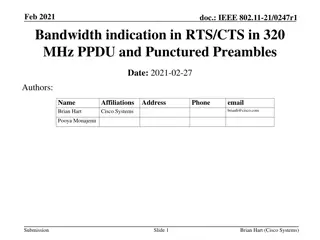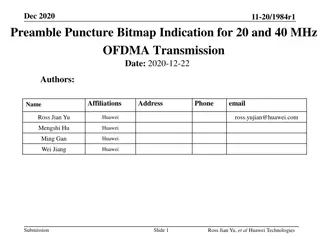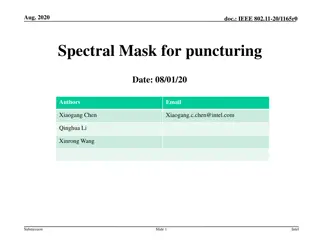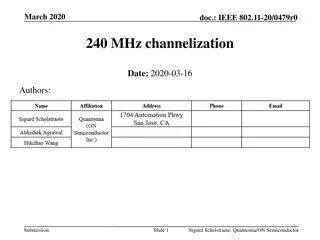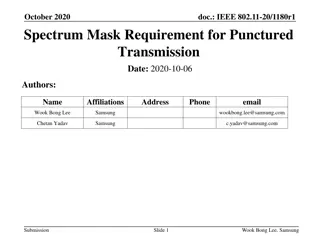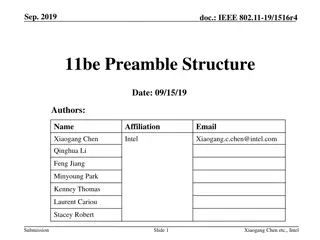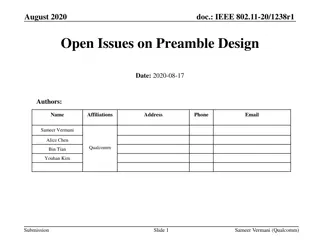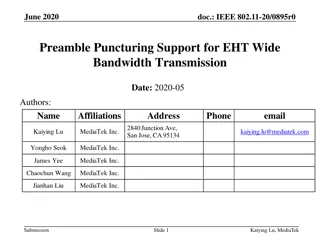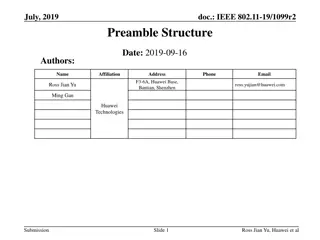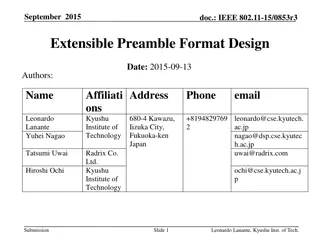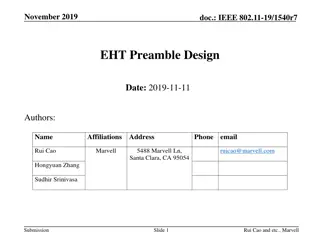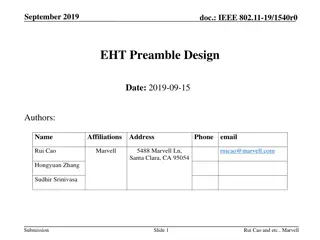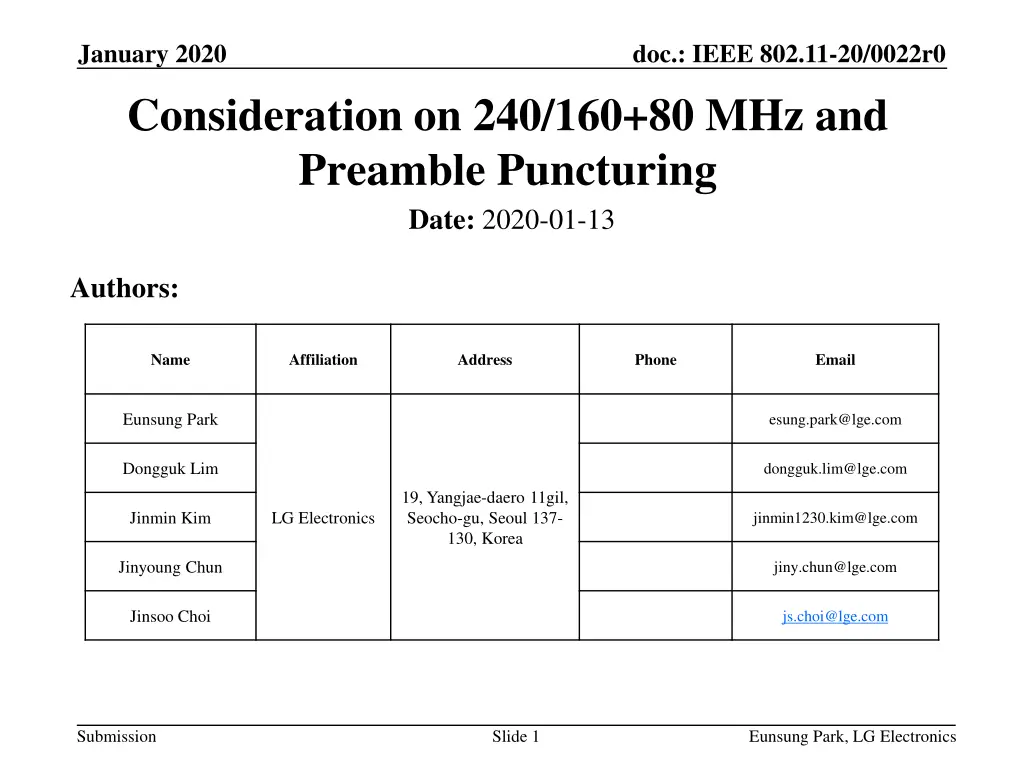
IEEE 802.11-20/0022r0 Consideration on 240/160+80 MHz and Preamble Puncturing
Explore the considerations and discussions regarding the implementation of 240/160+80 MHz transmission in IEEE 802.11 standards, including channelization options, bandwidth indication methods, and mechanisms for determining and indicating the necessary channel configurations. The document addresses fixed and flexible cases for channel allocation, highlighting key aspects related to MAC and PHY indications for efficient transmission.
Uploaded on | 1 Views
Download Presentation

Please find below an Image/Link to download the presentation.
The content on the website is provided AS IS for your information and personal use only. It may not be sold, licensed, or shared on other websites without obtaining consent from the author. If you encounter any issues during the download, it is possible that the publisher has removed the file from their server.
You are allowed to download the files provided on this website for personal or commercial use, subject to the condition that they are used lawfully. All files are the property of their respective owners.
The content on the website is provided AS IS for your information and personal use only. It may not be sold, licensed, or shared on other websites without obtaining consent from the author.
E N D
Presentation Transcript
January 2020 doc.: IEEE 802.11-20/0022r0 Consideration on 240/160+80 MHz and Preamble Puncturing Date: 2020-01-13 Authors: Name Affiliation Address Phone Email Eunsung Park esung.park@lge.com Dongguk Lim dongguk.lim@lge.com 19, Yangjae-daero 11gil, Seocho-gu, Seoul 137- 130, Korea Jinmin Kim LG Electronics jinmin1230.kim@lge.com Jinyoung Chun jiny.chun@lge.com Jinsoo Choi js.choi@lge.com Submission Slide 1 Eunsung Park, LG Electronics
January 2020 doc.: IEEE 802.11-20/0022r0 Introduction In the November F2F meeting, TGbe decided to support 240/160+80 MHz transmission 240/160+80 MHz consists of three 80MHz channels including primary 80MHz and the tone plan of each 80MHz is the same as the 11ax 80MHz tone plan One of the remaining issues on 240/160+80 MHz transmission is how to determine three 80MHz channels Fixed case by defining 240MHz channelization Flexible case by MAC indication Flexible case by PHY indication We discuss this issue and also deal with a bandwidth indication method including preamble puncturing in SU and MU PPDU Submission Slide 2 Eunsung Park, LG Electronics
January 2020 doc.: IEEE 802.11-20/0022r0 240/160+80 MHz Channel (1/4) Fixed case 240MHz channelization 240MHz channelization can be defined similar to 20/40/80/160 MHz This approach is reasonable in consideration of the current band plan in 5GHz and 6GHz In some bands (e.g., UNII8), contiguous 240MHz can be supported but contiguous 320MHz is not possible Since different regulation applies to each band, it may not be feasible to make a wide bandwidth across multiple bands Regardless of the 320/160+160 MHz channel, the 240/160+80 MHz channel can be defined, i.e., 240MHz BSS can be defined We don t need any additional mechanism to determine and indicate three 80MHz channels The gain may be less than using flexible 240/160+80 MHz channel in terms of efficiency Additional hardware requirements may need to be defined Static 240/160+80 MHz channel Submission Slide 3 Eunsung Park, LG Electronics
January 2020 doc.: IEEE 802.11-20/0022r0 240/160+80 MHz Channel (2/4) Flexible case MAC indication (e.g., Beacon) AP determines three 80MHz channels (i.e., one 160MHz channel and one 80MHz channel) used for 240/160+80 MHz transmission and indicates it via a management frame It may be performed in 320MHz BSS Before PPDU transmission, STAs acquire the exact channel information for 240/160+80 MHz PHY signaling may be simple The mechanism to select three 80MHz channels is required but it is performed on a long-term basis It may be less flexible than the PHY indication case (semi-) Static 240/160+80 MHz channel Submission Slide 4 Eunsung Park, LG Electronics
January 2020 doc.: IEEE 802.11-20/0022r0 240/160+80 MHz Channel (3/4) Flexible case PHY indication (e.g., U-SIG, EHT-SIG) If 240/160+80 MHz PPDU is transmitted, the exact channel information is indicated in the PHY signaling field Several fields can be considered which contain bandwidth information, preamble puncturing pattern information or RU information The PHY signaling overhead may be high It is the most flexible method in terms of the channel availability because several types (maybe three types) of 240/160+80 MHz are possible The 240/160+80 MHz channel depends on the 320/160+160 MHz channel 240/160+80 MHz transmission is possible only in 320MHz BSS 240/160+80 MHz can be even indicated as one of the 320/160+160 MHz bandwidth modes Dynamic 240/160+80 MHz channel Submission Slide 5 Eunsung Park, LG Electronics
January 2020 doc.: IEEE 802.11-20/0022r0 240/160+80 MHz Channel (4/4) Summary Pros Cons - - 240MHz BSS possible No need for any additional mechanism to determine the channel Simple PHY / MAC signaling Fixed case with channelization (Static channel) - - Less gain in terms of efficiency Additional hardware requirements may be required - - MAC needs a mechanism to determine the channel Relatively less gain in terms of efficiency Flexible case with MAC indication ((semi-)Static channel) - - Simple PHY signaling Receiver knows the exact 240/160+80 MHz channel in advance - - Most flexible in terms of channel availability Better gain in terms of average throughput - - Complex PHY signaling Receiver needs to acquire the exact 240/160+80 MHz channel information from the PHY signaling field Flexible case with PHY indication (Dynamic channel) - For a simple PHY signaling and low PHY overhead, we slightly prefer (semi-) static channel cases, i.e., fixed case with 240MHz channelization or flexible case with MAC indication Efficiency can be sufficiently enhanced by preamble puncturing or multiple RU aggregation already defined in 11be Slide 6 Submission Eunsung Park, LG Electronics
January 2020 doc.: IEEE 802.11-20/0022r0 Bandwidth and Preamble Puncturing Indication for SU PPDU (1/4) We propose the following fields to indicate the bandwidth and the preamble puncturing pattern for SU PPDU Bandwidth field in the version dependent field of U-SIG Modification of the 11ax bandwidth field Preamble puncturing field in the version dependent field of U-SIG Preamble puncturing pattern field in EHT-SIG Submission Slide 7 Eunsung Park, LG Electronics
January 2020 doc.: IEEE 802.11-20/0022r0 Bandwidth and Preamble Puncturing Indication for SU PPDU (2/4) We propose the following bandwidth field which is in the version dependent field of U-SIG for both static and dynamic channels 0: 20MHz 1: 40MHz 2: 80MHz 3: 160MHz and 80+80MHz 4: 240MHz and 160+80MHz 5: 320MHz and 160+160MHz 6~7: reserved The exact channel information of 240/160+80 MHz can be indicated in the bandwidth field for the dynamic channel case as in [1] 0: 20MHz 1: 40MHz 2: 80MHz 3: 160MHz and 80+80MHz 7: 320MHz and 160+160MHz 4: 240MHz and 160+80MHz mode 1 5: 240MHz and 160+80MHz mode 2 6: 240MHz and 160+80MHz mode 3 If the bandwidth field doesn t have this different mode information, the receiver needs to acquire the exact 240/160+80 MHz channel information from the preamble puncturing pattern field Submission Slide 8 Eunsung Park, LG Electronics
January 2020 doc.: IEEE 802.11-20/0022r0 Bandwidth and Preamble Puncturing Indication for SU PPDU (3/4) Whether preamble puncturing is applied to the PPDU can be also indicated in the bandwidth field as shown below 0: 20MHz 1: 40MHz 2: 80MHz non-preamble puncturing mode 3: 160MHz and 80+80MHz non-preamble puncturing mode 4: 240MHz and 160+80MHz non-preamble puncturing mode 5: 320MHz and 160+160MHz non-preamble puncturing mode 6: preamble puncturing in 80 MHz 7: preamble puncturing in 160 MHz or 80+80 MHz 8: preamble puncturing in 240 MHz or 160+80 MHz 9: preamble puncturing in 320 MHz or 160+160 MHz 10~15: reserved As an alternative way, a certain 1 bit field (i.e., preamble puncturing field) can be defined in the version dependent field of U-SIG By doing so, the preamble puncturing pattern field described in the next slide can be used for other purposes or just dropped when preamble puncturing is not applied Of course, if preamble puncturing is not indicated early, the preamble puncturing pattern field is always required Note that the dynamic channel case still needs the preamble puncturing pattern field if the exact 240/160+80 MHz channel information is not indicated in the bandwidth field although preamble puncturing is indicated early Slide 9 Submission Eunsung Park, LG Electronics
January 2020 doc.: IEEE 802.11-20/0022r0 Bandwidth and Preamble Puncturing Indication for SU PPDU (4/4) The preamble puncturing pattern field can be defined in EHT-SIG Even in SU PPDU, 20MHz based preamble puncturing can be applied by reusing the minimum CCA bandwidth resolution defined in the conventional Wi-Fi In this case, a simple bitmap method can be employed E.g., 1 bit per 20MHz can be used except for primary 20 (0: punctured, 1: used for transmission) Depending on the bandwidth, the total number of bits can be different 3, 7, 11 and 15 bits can be used for 80MHz, 160/80+80 MHz, 240/160+80 MHz and 320/160+160 MHz, respectively For the dynamic channel case, 240/160+80 MHz transmission needs 15 bits if the exact 240/160+80 MHz channel information is not indicated in the bandwidth field We can further reduce the bit size by limiting possible preamble puncturing patterns Submission Slide 10 Eunsung Park, LG Electronics
January 2020 doc.: IEEE 802.11-20/0022r0 Bandwidth and Preamble Puncturing Indication for MU PPDU (1/4) We propose the following fields which are obtained by modifying the corresponding 11ax fields to indicate the bandwidth and the preamble puncturing pattern for MU PPDU Bandwidth field in the version dependent field of U-SIG RU allocation and Center 26-tone RU fields in the common field of EHT- SIG User field in the user specific field of EHT-SIG Submission Slide 11 Eunsung Park, LG Electronics
January 2020 doc.: IEEE 802.11-20/0022r0 Bandwidth and Preamble Puncturing Indication for MU PPDU (2/4) We propose the bandwidth field which has the following descriptions and those in the bandwidth field of 11ax and this field is contained in the version dependent field of U-SIG 240MHz and 160+80MHz non-preamble puncturing mode 320MHz and 160+160MHz non-preamble puncturing mode preamble puncturing in 240 MHz or 160+80 MHz, where in the primary 80 MHz of the preamble only the secondary 20 MHz is punctured preamble puncturing in 240 MHz or 160+80 MHz, where in the primary 80 MHz of the preamble the primary 40 MHz is present, and at least one 20 MHz subchannel that is not in the primary 40MHz is punctured preamble puncturing in 320 MHz or 160+160 MHz, where in the primary 80 MHz of the preamble only the secondary 20 MHz is punctured preamble puncturing in 320 MHz or 160+160 MHz, where in the primary 80 MHz of the preamble the primary 40 MHz is present, and at least one 20 MHz subchannel that is not in the primary 40MHz is punctured Note that we assume that the EHT-SIG structure is the same as HE-SIG- B and if we decide to use a different EHT-SIG structure, the descriptions can be changed Submission Slide 12 Eunsung Park, LG Electronics
January 2020 doc.: IEEE 802.11-20/0022r0 Bandwidth and Preamble Puncturing Indication for MU PPDU (3/4) The descriptions in the previous slide can be used for both static and dynamic channel cases but the descriptions may mean different patterns between static and dynamic channel cases The fixed case and flexible case with MAC indication (i.e., static channel case) have the same patterns because only one 240/160+80 MHz channel is possible While in the flexible case with PHY indication (i.e., dynamic channel case), the patterns can be slightly different from the static channel cases since three modes are possible for 240/160+80 MHz channel In Appendix, the detailed non-preamble puncturing and preamble puncturing patterns are described for both static and dynamic channels For the dynamic channel case, different modes of 240/160+80 MHz can be indicated in the bandwidth field to reduce the overhead for RU allocation and user fields Submission Slide 13 Eunsung Park, LG Electronics
January 2020 doc.: IEEE 802.11-20/0022r0 Bandwidth and Preamble Puncturing Indication for MU PPDU (4/4) RU allocation and user fields indicate the RU plan of each 20MHz channel and user information assigned to each RU, respectively, and they can be defined in EHT-SIG (common and user specific fields, respectively) By using these field, the preamble puncturing pattern can be also identified at receivers if preamble puncturing is applied According to the bandwidth, the total number of bits for the RU allocation field can be different because this field exists in each 20MHz channel For the dynamic channel case, if exact 240/160+80 MHz channel information is not indicated in the bandwidth field, the RU allocation field for 240/160+80 MHz also requires the same amount of bits used in 320/160+160 MHz Submission Slide 14 Eunsung Park, LG Electronics
January 2020 doc.: IEEE 802.11-20/0022r0 Conclusion We have discussed how to determine 240/160+80MHz channel Fixed case with channelization Flexible case with MAC indication Flexible case with PHY indication We slightly prefer the static channel case We have also proposed some fields to indicate the bandwidth and preamble puncturing patterns in SU and MU PPDU SU PPDU Bandwidth field in the version dependent field of U-SIG Preamble puncturing field in the version dependent field of U-SIG Preamble puncturing pattern field in EHT-SIG MU PPDU Bandwidth field in the version dependent field of U-SIG RU allocation and Center 26-tone RU fields in the common field of EHT-SIG User field in the user specific field of EHT-SIG Slide 15 Static channel Dynamic channel Submission Eunsung Park, LG Electronics
January 2020 doc.: IEEE 802.11-20/0022r0 Straw Poll #1 Which option do you prefer for the 240/160+80 MHz channel? Option 1: Fixed case with 240MHz channelization Option 2: Flexible case with MAC indication (e.g., Beacon frame) Option 3: Flexible case with PHY indication (e.g., U-SIG, EHT-SIG) Option 1/Option 2/Option 3/A: /// Submission Slide 16 Eunsung Park, LG Electronics
January 2020 doc.: IEEE 802.11-20/0022r0 Straw Poll #2 Do you agree to add the following text to the TGbe SFD? For the PPDU transmitted to SU, the bandwidth field having 3 bits is contained in the U-SIG as one of the version dependent fields and has the following descriptions 0: 20MHz 1: 40MHz 2: 80MHz 3: 160MHz and 80+80MHz 4: 240MHz and 160+80MHz 5: 320MHz and 160+160MHz 6~7: reserved Y/N/A: // Submission Slide 17 Eunsung Park, LG Electronics
January 2020 doc.: IEEE 802.11-20/0022r0 Straw Poll #3 Do you agree to add the following text to the TGbe SFD? For the PPDU transmitted to SU, the preamble puncturing field having 1 bit is contained in the U-SIG as one of the version dependent fields and has the following descriptions 0: Preamble puncturing is not applied to the PPDU 1: Preamble puncturing is applied to the PPDU Note: The field name can be changed Y/N/A: // Submission Slide 18 Eunsung Park, LG Electronics
January 2020 doc.: IEEE 802.11-20/0022r0 Straw Poll #4 Do you agree to add the following text to the TGbe SFD? For the PPDU transmitted to SU, the preamble puncturing pattern field having TBD bits is contained in EHT-SIG Detailed descriptions are TBD Note: The field name can be changed Y/N/A: // Submission Slide 19 Eunsung Park, LG Electronics
January 2020 doc.: IEEE 802.11-20/0022r0 Straw Poll #5 Do you agree to add the following text to the TGbe SFD? For the PPDU transmitted to MU, the bandwidth field having TBD bits is contained in the U-SIG as one of the version dependent fields and has the following descriptions as well as the descriptions of the bandwidth field for HE MU PPDU 240MHz and 160+80MHz non-preamble puncturing mode 320MHz and 160+160MHz non-preamble puncturing mode preamble puncturing in 80 MHz, where in the preamble only the secondary 20 MHz is punctured preamble puncturing in 240 MHz or 160+80 MHz, where in the primary 80 MHz of the preamble only the secondary 20 MHz is punctured preamble puncturing in 240 MHz or 160+80 MHz, where in the primary 80 MHz of the preamble the primary 40 MHz is present, and at least one 20 MHz subchannel that is not in the primary 40MHz is punctured preamble puncturing in 320 MHz or 160+160 MHz, where in the primary 80 MHz of the preamble only the secondary 20 MHz is punctured preamble puncturing in 320 MHz or 160+160 MHz, where in the primary 80 MHz of the preamble the primary 40 MHz is present, and at least one 20 MHz subchannel that is not in the primary 40MHz is punctured Other descriptions are TBD Y/N/A: // Submission Slide 20 Eunsung Park, LG Electronics
January 2020 doc.: IEEE 802.11-20/0022r0 Straw Poll #6 Do you agree to add the following text to the TGbe SFD? For the PPDU transmitted to MU, the RU allocation and Center 26-tone RU fields having TBD bits are contained in the common field of EHT-SIG The RU allocation and Center 26-tone RU fields indicate the RU plan similar to that used in HE MU PPDU Detailed descriptions are TBD Y/N/A: // Submission Slide 21 Eunsung Park, LG Electronics
January 2020 doc.: IEEE 802.11-20/0022r0 Straw Poll #7 Do you agree to add the following text to the TGbe SFD? For the PPDU transmitted to MU, the User field having TBD bits is contained in the user specific field of EHT-SIG The User field indicates user information assigned to each RU similar to that used in HE MU PPDU Detailed descriptions are TBD Y/N/A: // Submission Slide 22 Eunsung Park, LG Electronics
January 2020 doc.: IEEE 802.11-20/0022r0 References [1] 802.11-19/1889r2 Discussion on 240MHz Bandwidth Submission Slide 23 Eunsung Park, LG Electronics
January 2020 doc.: IEEE 802.11-20/0022r0 Appendix Non-Preamble Puncturing and Preamble Puncturing Patterns for MU PPDU Submission Slide 24 Eunsung Park, LG Electronics
January 2020 doc.: IEEE 802.11-20/0022r0 Preamble Puncturing Patterns for Primary 80 In each description for preamble puncturing, P80 has the following preamble puncturing pattern preamble puncturing in 240 MHz or 160+80 MHz, where in the primary 80 MHz of the preamble only the secondary 20 MHz is punctured preamble puncturing in 320 MHz or 160+160 MHz, where in the primary 80 MHz of the preamble only the secondary 20 MHz is punctured :Punctured P20 S20 L20 H20 P40 S40 preamble puncturing in 240 MHz or 160+80 MHz, where in the primary 80 MHz of the preamble the primary 40 MHz is present, and at least one 20 MHz subchannel that is not in the primary 40MHz is punctured preamble puncturing in 320 MHz or 160+160 MHz, where in the primary 80 MHz of the preamble the primary 40 MHz is present, and at least one 20 MHz subchannel that is not in the primary 40MHz is punctured P20 S20 L20 H20 P20 S20 L20 H20 P20 S20 L20 H20 Submission Slide 25 Eunsung Park, LG Electronics
January 2020 doc.: IEEE 802.11-20/0022r0 Static Channel (1/3) We assume the following channel is used for 320MHz non- preamble puncturing Lower 80 (L80) Higher 80 (H80) Primary 80 (P80) Secondary 80 (S80) Secondary 160 (S160) Primary 160 (P160) Then, for the static channel, one of the following three patterns can be used for 240/160+80 MHz non-preamble puncturing PPDU is transmitted by using P80, S80 and H80 PPDU is transmitted by using P80, S80 and L80 PPDU is transmitted by using P80, L80 and H80 Three patterns above can be simply classified into two cases, i.e., 240MHz with S80 and without S80 E.g., Static 240MHz with S80 Higher 80 (H80) Primary 80 (P80) Secondary 80 (S80) Static 240MHz without S80 Lower 80 (L80) Higher 80 (H80) Primary 80 (P80) Submission Slide 26 Eunsung Park, LG Electronics
January 2020 doc.: IEEE 802.11-20/0022r0 Static Channel (2/3) For the static 240/160+80 MHz channel with S80, the following preamble puncturing patterns can be indicated as 240/160+80 MHz preamble puncturing At least one of the 20MHz channels in the 80MHz channel which is not in P160 is used for transmission regardless of whether any 20MHz channels in S80 are used for transmission Higher 80 (H80) Primary 80 (P80) Secondary 80 (S80) : at least one 20MHz channel is used for transmission : don t care whether any 20MHz channel is used for transmission or not For the static 240/160+80 MHz channel with S80, the following preamble puncturing patterns can be indicated as 320/160+160 MHz preamble puncturing At least one of the 20MHz channels in the 80MHz channel which is not included in the 240/160+80 MHz channel is used for transmission Lower 80 (L80) Higher 80 (H80) Primary 80 (P80) Secondary 80 (S80) Submission
January 2020 doc.: IEEE 802.11-20/0022r0 Static Channel (3/3) For the static 240/160+80 MHz channel without S80, the following preamble puncturing patterns can be indicated as 240/160+80 MHz preamble puncturing At least one of the 20MHz channels in the S160 is used for transmission Lower 80 (L80) Higher 80 (H80) Primary 80 (P80) For the static 240/160+80 MHz channel without S80, the following preamble puncturing patterns can be indicated as 320/160+160 MHz preamble puncturing At least one of the 20MHz channels in S160 as well as at least one of the 20MHz channels in S80 is used for transmission Lower 80 (L80) Higher 80 (H80) Primary 80 (P80) Secondary 80 (S80) If no 20MHz channel is used in S160, it is preamble puncturing in 160/80+80MHz Submission Slide 28 Eunsung Park, LG Electronics
January 2020 doc.: IEEE 802.11-20/0022r0 Dynamic Channel (1/2) For the dynamic channel, all of the following three patterns can be indicated as 240/160+80 MHz non-preamble puncturing PPDU is transmitted by using P80, S80 and H80 PPDU is transmitted by using P80, S80 and L80 PPDU is transmitted by using P80, L80 and H80 Submission Slide 29 Eunsung Park, LG Electronics
January 2020 doc.: IEEE 802.11-20/0022r0 Dynamic Channel (2/2) For the dynamic channel, all of the following preamble puncturing patterns can be indicated as 240/160+80MHz preamble puncturing At least one of the 20MHz channels in only one of the 80MHz channels in S160 is used for transmission regardless of whether any 20MHz channels in S80 are used for transmission Higher 80 (H80) Primary 80 (P80) Secondary 80 (S80) No 20MHz channel in S80 is used for transmission and at least one of the 20MHz channels in S160 is used for transmission Lower 80 (L80) Higher 80 (H80) Primary 80 (P80) For the dynamic channel, the following preamble puncturing patterns can be indicated as 320/160+160MHz preamble puncturing At least one of 20MHz channels in each of S80, L80 and H80 is used for transmission Lower 80 (L80) Higher 80 (H80) Primary 80 (P80) Secondary 80 (S80) Submission Slide 30 Eunsung Park, LG Electronics

